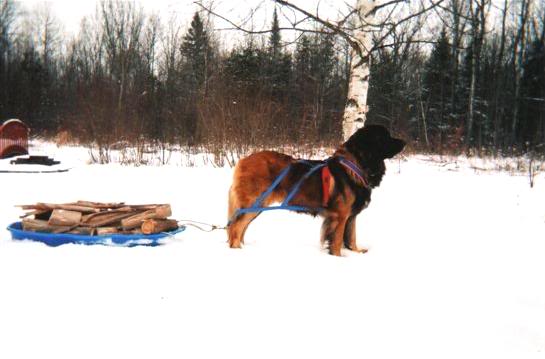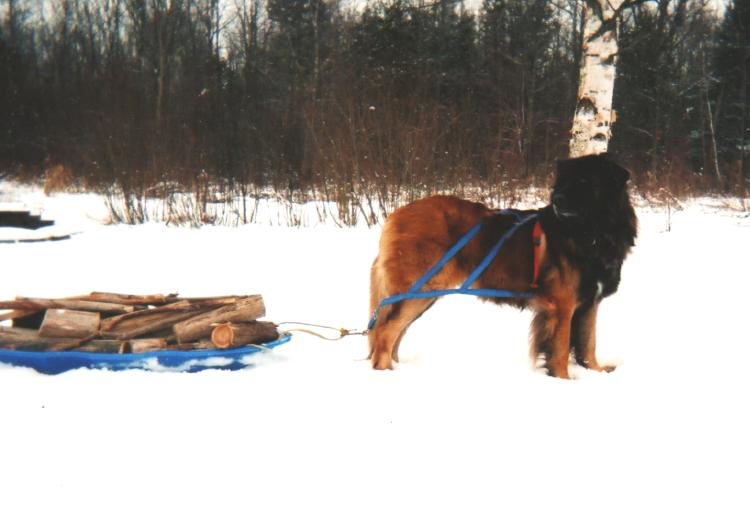|
Leonbergers At Work – Dog Carting and Drafting The use of dogs as draft animals has a long history. Newfoundlands hauled fishing nets in to shore for their owners. Swiss Mountain Dogs and Rottweilers hauled carts containing farm produce to market for their owners, and numerous other large breeds, among them Leonbergers, have been used over the centuries to haul firewood home. Although using dogs as draft animals is no longer extensively practiced out of necessity, more and more people are discovering the joys of involving the family dog in this sport.
Orovale's Cool Hand Luke ("Luka"), TD, hc, VC Teaching your Leonberger to pull a cart, a wagon, a sled, or you on Rollerblades or skis (called ‘Skijoring’) is not a hard activity at all to learn. The three most important things you need to get started is your veterinarian, a good quality Pulling Harness, and your time. Like all new exercise programs, your dog will first need a thorough physical by his veterinarian to ensure he is healthy and has no “hidden” heart, joint or other problems. After you get your vet’s “okay”, the next thing you need is a quality Drafting, or Pulling Harness. There are different styles available and whichever one you choose, be sure it is designed for pulling and that it’s not a walking harness. Nothing will spoil your fun and ruin a dog faster than an ill fitting harness! After these things are done, it is time for you and your Leo to work on getting used to wearing her harness and getting used to all the things that go with it (traces, shafts, etc.). A word to the wise is necessary here. Fitting the dog for and learning to use the equipment should be done under the supervision of an experienced draft instructor to avoid injury to the dog. While training it is important to make sure that all lessons are slow and POSITIVE. Punishment or negative reinforcement will only sour you and the dog to the sport. Remember, this is supposed to be fun! So go slow, steady and you’ll all be happy in the long run.
Here are some Frequently Asked Questions about carting and draft work involving dogs :
What is the difference between Carting, Drafting and Driving ? “Draft Work” refers to an activity where a dog is pulling something – a cart, a wagon, a sled, or even a log. “Carting” refers to an activity where the dog pulls a wheeled vehicle with the handler walking alongside the dog, and “Driving” refers to carting activity where the person controlling the dog rides in the vehicle being pulled.
How old should my dog be ? You can start getting a dog used to wearing a harness as soon as he is big enough to fit the harness (usually around six months of age), but bear in mind that most harnesses won’t grow as much as your dog will, so what fits as a puppy will be useless long before you can use it for real draft work! Most places that train dogs to cart insist that the serious training involving weight be delayed until the dog has finished its major growth. Leonbergers and other giant breed dogs under 18 months of age should not pull any weight at all since they aren’t fully developed yet and there is a very high risk of serious injury to the bones and joints as a result.
What equipment do I need ? As mentioned previously, the first thing you need is a healthy, sound dog. If you’re acquiring your equipment a bit at a time, the best first purchase you can make is a good harness that fits your dog properly. If you are taking part in events, you can usually borrow a cart or wagon, or ‘switch off’ with someone else’s dog. But you want, no NEED, your dog’s harness to fit properly, without chafing, in order to maximize your dog’s comfort and enjoyment of the sport. Once you have a harness, you can look at getting your cart or wagon. What you need depends upon what you want to do. If you want to haul firewood around, a wagon is probably a better choice than a cart. If you want to carry kids in parades, then a cart with a seat is probably a better starting point. Most people seem to end up with a few different vehicles to hook their dogs to, since each vehicle has a purpose.
Where can I get carting equipment ? Although carting equipment is sometimes difficult to find, many of the traditional ‘carting’ breed clubs have a list of vendors available. However, carts are big, heavy objects and shipping adds significantly to the cost, which is why some prefer to build their own. Many vendors, as well as the carting breed clubs, have plans available if that is the route you wish to take.
What factors affect the speed at which a dog can pull a vehicle ? The factors include weight and fitness of the dog, the weight and balance of the vehicle, the weight of the driver, the size of the wheels and, lastly, the terrain. Given this many variables it is difficult to generalize about speeds carting dogs achieve, but as a general rule large breeds will trot at 12 – 16 km/hour over level ground. Some breeds prefer to pace rather than trot (that is, swinging left legs then right legs, rather than picking up the front left/back right legs and then the front right/back left legs), and can maintain their speed over considerable distances (more than a kilometer).
Orovale's Cool Hand Luke, HIC, TD ("Luka") Carting / Drafting Terminology : Harness – This is what the dog wears to pull. Shafts – These are rigid poles positioned parallel on either side of the dog. They not only keep the dog in place and pulling straight, but act as the steering component as well, moving the cart right or left with the dog. Shafts also act as brakes, and automatically stop the cart or wagon from running over the dog when the vehicle is going down hill or comes to a halt. Whipple Tree (also known as a Swingle Tree) – This is a bar that is attached to the wagon or cart and which pivots freely between the shafts. It is slightly wider than the dog and has attachment points for the traces at each end. The traces are attached to the Whipple Tree rather than directly to the cart to allow for proper movement of the dog since it translates the side-to-side pull of the dog’s shoulders to pulling the center of the wagon. Traces – These are the straps that connect to the Whipple Tree. The dog actually pulls with the traces. Reins – These are sometimes used with driving dogs, and are usually attached to a collar or a head halter and are used to signal the draft animal.
Terms for Vehicles : Cart – this refers to a two-wheeled vehicle. While some styles are designed to carry passengers, much like a harness racing sulky, carts may also be used to haul freight. If the cart is loaded incorrectly, however, all the weight may be on the dog so care must be taken to balance the load so that NO weight is on the dog. Wagon – this refers to a four-wheeled vehicle. These may carry freight or passengers, and usually have a greater capacity than a cart. It is relatively easy to make a dog-drawn wagon from a child’s wagon. Travois – this is a no-wheeled device which is dragged by the dog. These are useful when crossing rough terrain. Some are made of wood, while others are made of aluminum.
Terms for Harness Types : There are several different styles of harness. These include Parade Harness, Siwash Harness and Draft Harness. Use of one style over another is often a matter of personal preference – sometimes it’s your preference, and sometimes it’s your dog’s preference. Listen to your dog! She will let you know if a certain type of harness makes her happy to work. A dog that doesn’t like a particular harness will not work well. Often a change in harness will make the dog a happy carter again. Note that there are many successful dogs working in all styles of harness, including ‘home-brewed’ designs. The most important part of the harness is that it fits well, whatever the style. Parade Harness – this consists of a padded strap that goes across the withers and circles the dog’s chest, and a second padded strap that wraps around the front of the dog across the fore chest. The straps could be leather or nylon webbing, and they are often buckled together. Some find this style of harness may constrict the free motion of the dog’s shoulders or legs. Siwash Harness – this looks more like a sled dog harness, with a series of straps crossing the dog’s back, between two straps that extend past the rear of the dog, parallel to the ground. The dog’s head comes out through a padded chest strap that follows down the breastbone and back through the front legs. A belly band provides the connection point for the cart shafts. Dogs have free range of shoulder and leg motion in this type of harness, and most can generate lots of pulling power as a result. Draft Harness – this resembles the draft rigs normally seen on horses. A large padded collar provides the main pull, allowing the dog free shoulder and leg motion while allowing the dog to lean into the collar with shoulders and breastbone to increase pulling force as needed. A belly strap provides the shaft connection point, while the traces run back from the collar to the cart. This style of harness is typically made of leather.
Carting Commands : Many people often use different commands when their dog is in harness rather than simply on a leash. Here are some of the most popular commands used: “Hike” / “Giddy Up” / “Walk On” / “Start” / “Forward” – these are all commands for start to pull. “Back” – this is the command used for reversing or backing up “Whoa” / "Stop” / “Halt” – these are commands for stop pulling “Gee” / “Right” – this is the command for turn right “Haw” / “Left” – this is the command for turn left “On By” – this command is given to direct the dog to go straight or ignore a distraction.
In order to foster and maintain the working abilities that are an important part of the history of the Leonberger, training seminars designed around Draft Test criteria are available to help promote the working heritage of the breed. To learn more about Draft Tests, click on this link. And for more information on drafting and carting with your Leo please contact us at info@LeonbergerClubOfOntario.com
|
|
|
|
|
|
Page Last Updated April 7, 2010 |
|
|
Visitor # /
|
|
Leonberger Club of Ontario


